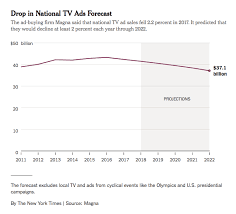Which means the ad dollars (and euros, yuan etc) are following them. And as if that weren't enough, marketers are reducing the number of TV ads per show because a population grown accustomed to fewer ads on their entertainment option of choice won't stand for advertising interruptions at a rate of 14 minutes out of every 60.
TV has been written off before, but its economic justification is dying, literally and figuratively. JL
Sapna Maheshwari and John Koblin report in the New York Times:
The hottest shows on TV networks — which command the highest ad prices — are attracting older viewers, which is a challenge for brands that want to reach millennials and teens. As TV ad spending has begun to drop, marketers have been diverting more money to Google and Facebook, which have increasingly focused on expanding their video — and video ad — business. Companies love digital advertising because it gives them the ability to target ads based on their own lists of customersTelevision networks will draw hordes of advertisers to New York City for their annual bonanza of presentations and parties, a decades-old tradition known as the upfronts that is meant to dazzle marketers and loosen their purse strings.New shows and top talent will be pitched from the stages of Carnegie Hall and Lincoln Center, followed by lavish evening affairs where marketers can eat lobster rolls and snag selfies with network stars. The fanfare will kick off weeks of negotiations, with networks aiming to get advertisers to commit to billions of dollars in spending for the year ahead.But beneath the sparkle and the canapés, the networks are also navigating a serious advertising upheaval. Ratings are on the decline, especially among young people, some of whom don’t even own televisions. It’s hard to keep up with the many devices and apps people now use to watch shows. And there is a host of material from Silicon Valley that is competing for viewers’ attention, including Google’s YouTube, Facebook and Netflix. It all adds up to a precarious situation for broadcast TV.Advertising on TV has long been the best way for marketers to reach a large number of people at one time. And it is still a formidable medium. But cracks are showing.National TV ad sales peaked in 2016, when they exceeded $43 billion, according to data from Magna, the ad-buying and media intelligence arm of IPG Mediabrands. Sales fell 2.2 percent last year, and the firm estimates that they will fall at least 2 percent each year through 2022.Some of the decline could be mitigated through new business with platforms like Hulu, but “it’s not yet enough to upset the decrease of traditional sales,” said Vincent Letang, Magna’s executive vice president of global market intelligence. At the same time, he said, while networks have raised the cost of advertising on their airwaves in recent years, ratings have declined sharply, including some in unexpected areas like the National Football League.TV is still a good value for plenty of advertisers. Mr. Letang said pharmaceuticals and personal care products were increasing their presences on TV. But the combination of rising prices and falling viewership is giving some big brands pause.The hottest shows on TV networks — which command the highest ad prices — are attracting older viewers, which is a challenge for brands that want to reach millennials and teens. For instance, this season’s top-rated show, the revival of “Roseanne,” has a median viewer age of 52.9 years. The network show with the lowest median age is “Riverdale” on the CW, at 37.2.Google’s YouTube, on the other hand, is wildly popular with much younger viewers. And the brands are so eager to reach those viewers that they have been willing to continue advertising on YouTube despite the issues it has faced around ads showing up on offensive content, like racist videos.As TV ad spending has begun to drop, marketers have been diverting more money to tech giants like Google and Facebook, which have increasingly focused on expanding their video — and video ad — business.Companies love digital advertising because it gives them the ability to target ads based on their own lists of customers — like holders of store loyalty cards — and profiles like “first-time car buyers” or “people who like foreign travel.” And they want that kind of capability on TV, too. That desire has prompted four competing media companies — NBCUniversal, Turner, Viacom and Fox — to work to standardize the language and some of the data sets that they use, hoping to make it easier for brands to buy cross-platform advertising with them.























0 comments:
Post a Comment